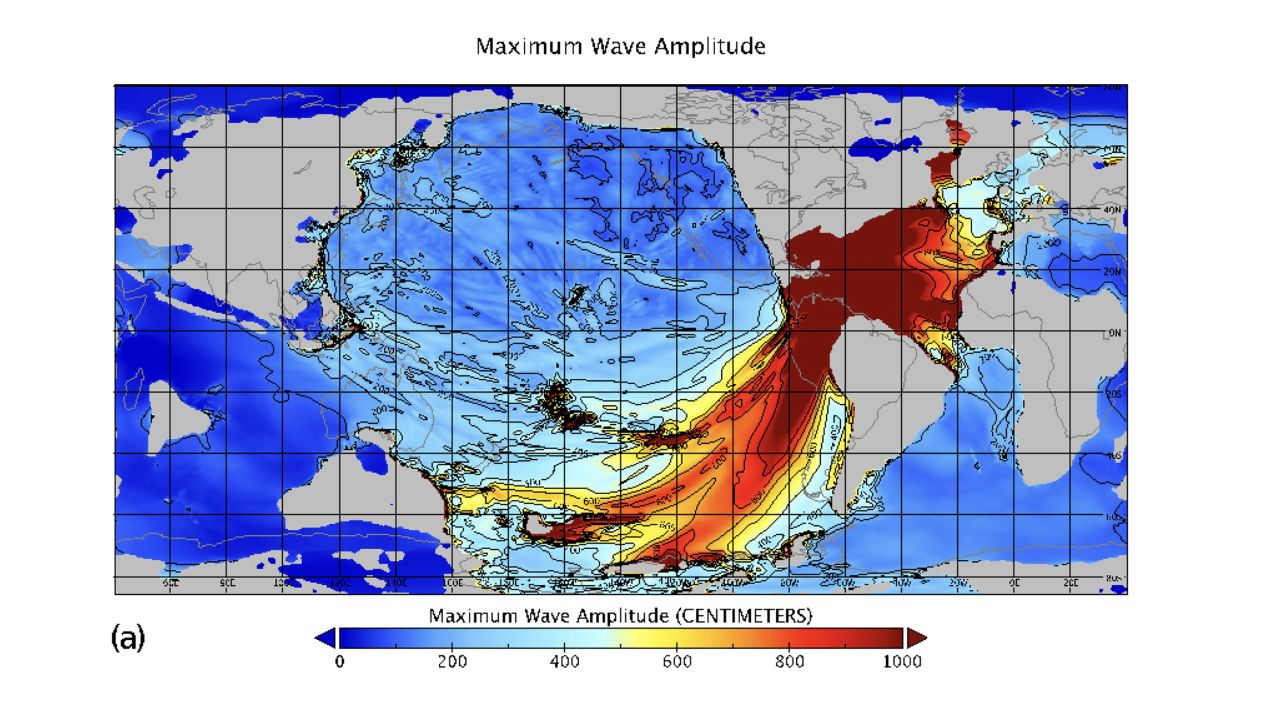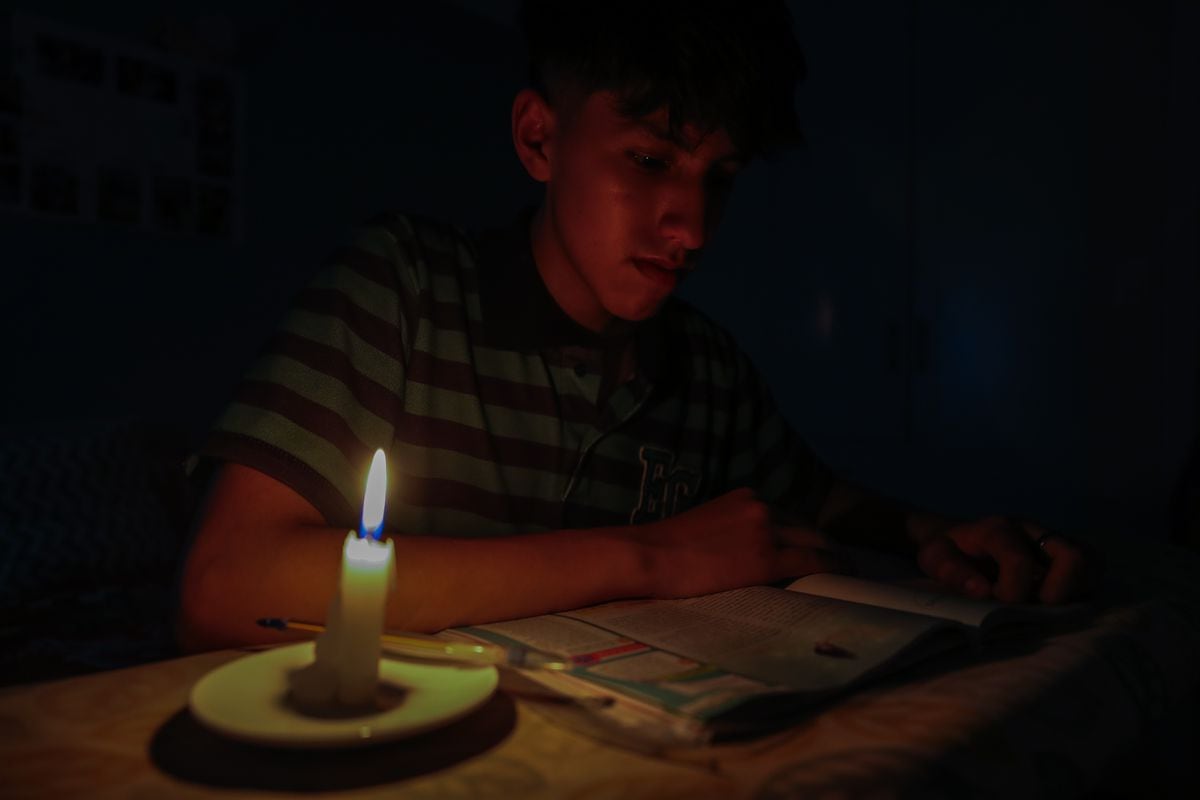(CNN) — When a city-sized asteroid slammed into Earth 66 million years ago, it wiped out the dinosaurs and sent a devastating tsunami that swept across the planet, new research suggests.
The asteroid, about 14 kilometers wide, left a crater about 100 kilometers in diameter near the Yucatan Peninsula in Mexico. In addition to ending the reign of the dinosaurs, the direct impact caused the mass extinction of 75% of animal and plant life on the planet.
This model shows the maximum amplitude of the tsunami wave after the asteroid impact 66 million years ago. Credit: De Range et al
When the asteroid struck, it created a series of cataclysmic events. Global temperatures fluctuated, aerosols, soot and dust filled the air, and wildfires ignited, as fragments of burning material ejected by the impact re-entered the atmosphere and rained down. Within 48 hours, a tsunami circled the globe and was thousands of times more powerful than modern tsunamis caused by earthquakes.
The researchers set out to better understand the tsunami and its size through modeling and by examining 120 ocean sediment centers around the world to back up their conclusions about the path and power of the tsunami. A study detailing the results was published in the journal Tuesday Proceedings of the American Geophysical Union.
According to the authors, this is the first global simulation of a Chixulup impact tsunami to be published in a peer-reviewed scientific journal.
According to the study, the tsunami was powerful enough to create waves more than a mile high and destroy the ocean floor thousands of miles away from where the asteroid struck. In fact, it erased the sedimentary record of what happened before and during the event.
“These tsunamis are strong enough to disturb and erode sediments in ocean basins around the world, leaving a gap in the sedimentary record, or a jumble of older sediments,” said lead author Molly Range, who began the work as an undergraduate. student and completed his master’s thesis at the University of Michigan.
Researchers estimate it was 30,000 times more powerful than the December 26, 2004 tsunami in the Indian Ocean, which killed more than 230,000 people. The energy of the asteroid’s impact was at least 100,000 times greater than the eruption of the Tonga volcano earlier this year.
Tracing the path of an ancient tsunami
Study co-author Brandon Johnson, an associate professor at Purdue University, used a large computer program called Hydrocode to simulate the first 10 minutes of Chicxulub’s impact.
This includes the size of the asteroid and its speed, which was estimated to be moving at 43,200 kilometers per hour when it hit the granite crust and shallow waters of the Yucatan Peninsula.
Within three minutes, rocks, sediment and other debris pushed the wall of water away from the impact, creating a wave 4.5 kilometers high, according to the simulation. The wave subsided as the detonated material fell back to Earth.
But as the debris fell, it created more chaotic waves.
Ten minutes after the impact, a ring-shaped wave approximately one kilometer high began traveling across the ocean in all directions from a point 220 kilometers from the impact.

This graph shows the sea surface height movement of the tsunami four hours after the asteroid impact. Credit: De Range et al
The simulation was run on two different global tsunami models, MOM6 and MOST. While MOM6 models deep ocean tsunamis, most are part of the National Oceanic and Atmospheric Administration’s (NOAA) Tsunami Warning Center’s tsunami forecast.
Both models produced nearly identical results, creating a tsunami timeline for the research team.
Within an hour of impact, the tsunami moved across the Gulf of Mexico and into the North Atlantic Ocean. Four hours after the attack, the waves passed through the Central American Channel and reached the Pacific Ocean. The Central America Canal once separated North America and South America.

This graph shows the sea surface elevation movement 24 hours after the tsunami hit. Credit: De Range et al
Within 24 hours, waves traveled through the Pacific and Atlantic Oceans and entered the Indian Ocean on both sides. And within 48 hours of the impact, large tsunami waves reached most of the Earth’s coastlines.
A changing sea floor
Undersea currents in the North Atlantic Ocean, Central American Ocean, and South Pacific Ocean were more than 643 meters per hour, strong enough to drag sediment from the ocean floor.
Meanwhile, the Indian Ocean, the North Pacific, the South Atlantic and the Mediterranean were protected with smaller currents that were worse for the tsunami.
The team analyzed data from 120 sediments, mostly from previous scientific ocean drilling projects. There were more sediments in the water that protected it from the tsunami’s fury.
But gaps were also found in the sedimentary record of the North Atlantic and South Pacific oceans.
The researchers were surprised to find that the sediments along the east coast of New Zealand’s North and South Islands were heavily disturbed with many lagoons. Initially, scientists thought it was due to plate tectonic activity.
But the new model shows the sediments are directly in the path of the Chicxulub tsunami, even though it is 12,000 kilometers away.
“We believe these deposits record the effects of a tsunami impact and may be a strong confirmation of the global importance of this event,” Range said.
Although the team did not estimate the tsunami’s impact on coastal flooding, the model showed that coastal areas of the North Atlantic and Pacific coasts of South America could have been hit by waves higher than 20 meters. As the tide approaches the shore, it swells, causing flooding and erosion.
According to study co-author Brian Orbick, a University of Michigan professor and physical oceanographer, the extent of global flooding after the impact and how far the effects of the tsunami may have been felt inland will be examined in the future.
“Obviously the biggest flooding would have been near the point of impact, but even further away the waves could have been much bigger,” Orbig said.




:format(jpeg)/cloudfront-us-east-1.images.arcpublishing.com/gfrmedia/MLWQMNTDJ5AUTBLCI67DXYEHFE.jpg)
